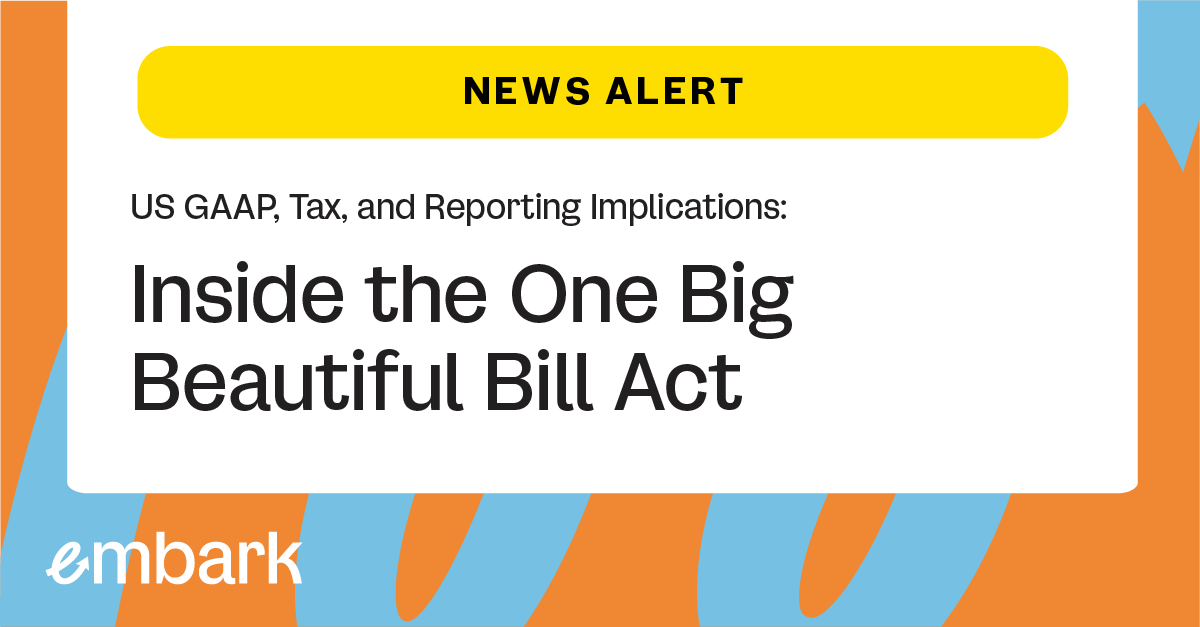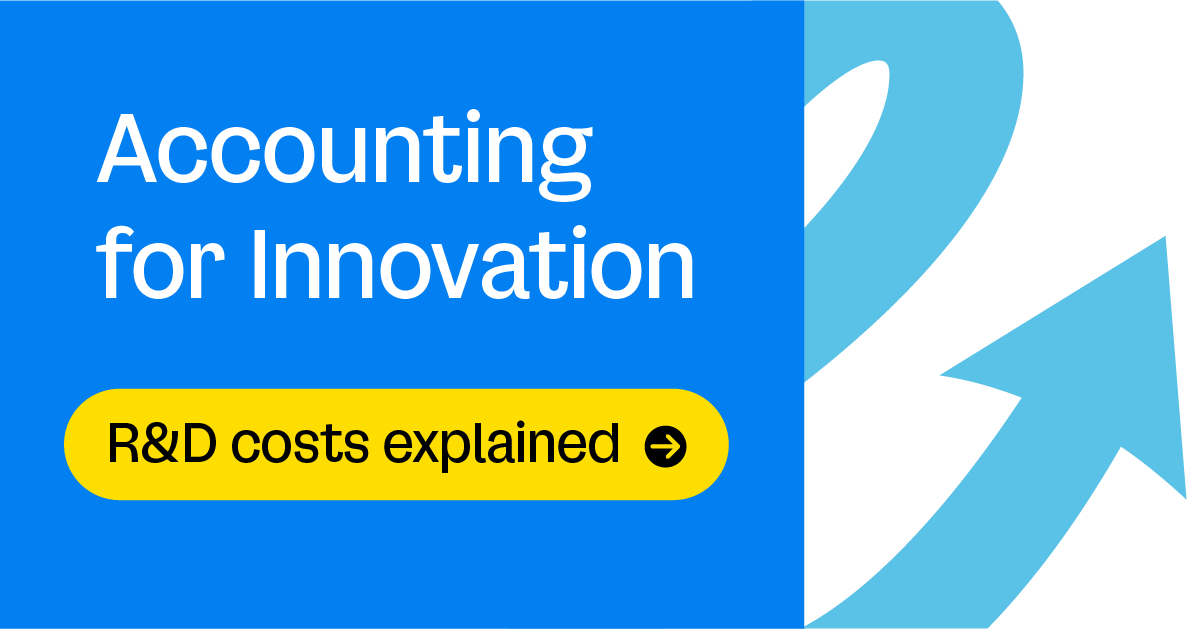
On July 4, 2025, while most Americans celebrated Independence Day with fireworks and family barbecues, a different kind of spark was lit in Washington. President Donald Trump signed the One Big Beautiful Bill Act (OBBBA) — an 870-page legislative powerhouse reshaping the tax and policy landscape for businesses across the country.
For CFOs and controllers, this bill demands immediate attention. Beyond the headlines about personal tax relief and SALT cap changes, OBBBA introduces complex corporate-facing provisions with far-reaching implications — including the extension of key Tax Cuts and Jobs Act (TCJA) elements, the rollback of clean energy credits introduced under the Inflation Reduction Act (IRA), and international tax changes that will materially alter tax planning for multinational operations.
And while this isn’t the first time a major tax bill has dropped mid-summer, the stakes for financial reporting are high. Companies must quickly assess the timing of enactment, evaluate its impact on current and future reporting periods, and recalibrate tax strategies and disclosures accordingly — especially for Q3 reporting.
In this blog, we break down OBBBA’s most relevant provisions for the office of the CFO — from enactment-date accounting impacts to sector-specific insights. Whether you're leading finance at a PE-backed platform, managing reporting for a multinational, or preparing for year-end, we’ll help you connect the dots between tax law and financial reporting reality.
US GAAP Accounting for Tax Law Changes: Timing Is Everything
While the headlines focus on the political win, finance teams know the real impact of tax legislation lies in how — and when — it’s accounted for under US GAAP.
Under ASC 740, the effects of tax law changes must be recorded in the period of enactment — the date the President signs the bill. For OBBBA, that date is July 4, 2025. If your reporting period ends before that — say, June 30 — the change is considered a nonrecognized subsequent event under ASC 855. That means the law doesn’t impact your Q2 financials, but it does require disclosure of the new law’s nature and potential impact if estimable.
However, companies preparing interim financials for Q3 2025 must reflect the full tax effects of the bill. These changes — including adjustments to deferred tax balances, valuation allowances, and uncertain tax positions — should be recorded as discrete items in the income tax provision for continuing operations. This ensures the enactment impact is isolated from the company’s ordinary tax rate.
Given the variety of effective dates for OBBBA provisions, not all tax changes will hit at once. Some will affect Q3; others won’t take effect until 2026 or beyond. This staggered timing requires tax and accounting teams to stay vigilant and model out provision impacts across multiple reporting periods.
And don’t forget your estimated annual effective tax rate (AETR). If earlier interim periods included assumptions about IRA credits or other tax benefits that are no longer available under OBBBA, those benefits must now be reversed. This could create unexpected volatility in your Q3 AETR — particularly for public companies with quarterly earnings releases.
Finally, state conformity matters. Not all jurisdictions automatically adopt changes to the Internal Revenue Code. Companies with a national footprint must evaluate how state-specific legislative processes affect income tax calculations at the state level.
Key Corporate Provisions & Tax Accounting Impacts: What Finance Leaders Should Prioritize
While the headlines surrounding the OBBBA have largely focused on individual tax relief and SALT cap adjustments, the implications for corporate taxpayers are far more nuanced — and significantly more complex. For finance leaders, several provisions of the new law warrant close scrutiny due to their accounting and reporting consequences under US GAAP.
Here are some of the most notable corporate-facing provisions and their tax accounting impacts.
100% Bonus Depreciation |
|
|
Overview |
Accounting impact |
|
OBBBA reinstates and makes permanent the ability for companies to fully expense 100% of the cost of qualified property in the year it’s placed in service — a revival of one of the more business-friendly elements of the original TCJA. The provision applies to property placed in service after January 19, 2025, and even introduces new eligibility for qualified production property through 2028. |
Full expensing will increase taxable temporary differences, generating deferred tax liabilities. At the same time, reduced current-period taxable income could give rise to additional deferred tax assets (DTAs) for net operating losses and unused credits. Companies must carefully evaluate how these changes affect their valuation allowance assessments and whether the resulting DTAs are realizable. |
Expensing US-Based R&D |
|
|
Overview |
Accounting impact |
|
Perhaps one of the more anticipated reversals, OBBBA permanently suspends the TCJA-era requirement to capitalize and amortize Section 174 US-based R&D expenditures. Taxpayers can now elect to expense R&D costs, amortize over the research life (minimum 60 months), or use a 10-year amortization. For small businesses, retroactive application to tax years beginning after December 31, 2021 is available. |
Companies must determine their election path and consider its impact on both current and deferred taxes. Electing to expense R&D could result in lower taxable income and new or increased DTAs, which may require reassessment of existing valuation allowances. Keep in mind that non-US R&D costs remain subject to capitalization, further complicating multinational tax strategies. |
Interest Expense Limitation Adjustments |
|
|
Overview |
Accounting impact |
|
Under Section 163(j), interest deductions were already limited — but OBBBA permanently shifts the calculation of adjusted taxable income (ATI) to an EBITDA-like model. This could increase allowable deductions for many taxpayers. However, the new calculation must be made before applying most interest capitalization rules, which may reduce benefits for asset-intensive businesses. Importantly, Subpart F and GILTI amounts are excluded from ATI beginning in 2026. |
Higher ATI could reduce DTAs for interest carryforwards, or even trigger valuation allowance releases if existing DTAs become realizable. However, the interplay with interest capitalization exclusions may dampen the benefit for some taxpayers. Careful modeling and reassessment of related deferred positions will be key. |
GILTI and FDII: Rebranded but Still Relevant |
|
|
Overview |
Accounting impact |
|
The international tax landscape also sees major reform. Global Intangible Low-Taxed Income (GILTI) and Foreign-Derived Intangible Income (FDII) have been rebranded, but the concepts remain intact. The Section 250 deduction percentages are trimmed to 40% for GILTI and 33.34% for FDII — equating to an effective 14% tax rate after accounting for the new 90% foreign tax credit. The law also eliminates the Qualified Business Asset Investment (QBAI) deduction. |
Most companies account for GILTI and FDII as period costs, so many of these changes won’t trigger immediate deferred tax re-measurement — unless they affect valuation allowances or a company has elected to recognize GILTI deferred taxes. In those cases, any deferreds expected to reverse after the effective date (post-2025) must be remeasured at enactment, with changes recorded discretely through continuing operations. |
Changes to the BEAT |
|
|
Overview |
Accounting impact |
|
The BEAT (Base Erosion and Anti-Abuse Tax) regime survives, albeit with a few modifications — including a new rate and updated calculation mechanics. These updates kick in for tax years beginning after December 31, 2025. |
BEAT is typically treated as a period cost, but for companies that consider BEAT in their valuation allowance assessments, the new law may change the realizability picture. Those changes should be reflected in the Q3 2025 reporting cycle, depending on how BEAT interacts with existing deferred positions. |
Several TCJA-related provisions included in OBBBA — such as those tied to depreciation or interest limitations — are retroactive to earlier points in 2025. For companies that have already booked originating deferreds in Q1 or Q2, those balances must be recalculated at the date of enactment and recognized as discrete items in Q3. Importantly, these adjustments are excluded from the forecasted annual effective tax rate.
Energy & Environmental Credits: A New Era of Uncertainty for Clean Energy Incentives
For companies in energy, clean tech, or sustainability-linked sectors, the OBBBA brings sweeping changes. Much of the clean energy credit framework established under the Inflation Reduction Act (IRA) is now being reversed or scaled back — with immediate implications for investment planning, tax strategy, and ESG positioning.
Several cornerstone credits are now subject to accelerated phase-outs or full repeal. These include:
- Clean vehicle credit (Section 30D) – Ends after September 30, 2025
- Alternative fuel vehicle refueling credit (Section 30C) – Ends after June 30, 2026
- Clean hydrogen (Section 45V) – Ends for projects not started by December 31, 2027
- Clean electricity credits (Sections 45Y & 48E) – Terminated for projects not begun within 12 months of enactment or placed in service after 2027
- Advanced manufacturing production credit (Section 45X) – Phases out 2031–2033
One bright spot, the advanced manufacturing investment credit (Section 48D) is increased to 35% for property placed in service after December 31, 2025.
These new restrictions will prevent certain clean energy credits from being claimed by entities with material ties to “prohibited foreign entities.” The rules include new compliance thresholds and tracking metrics, such as “material assistance cost ratios,” which may affect both eligibility and transferability.
From an accounting side, companies that previously factored clean energy credits into their 2025 forecasts must now adjust their AETR and revisit assumptions in deferred tax models. This includes companies planning to transfer credits as part of tax equity deals — a strategy that may no longer be viable under OBBBA’s new transferability limits.
Drilling Into the Details: What OBBBA Means for High-Growth and Capital-Intensive Sectors
OBBBA doesn’t just shift policy — it reshapes financial strategy for some of the most active and capital-intensive sectors. Whether it’s a private equity-backed portfolio company navigating post-deal complexity, a high-growth tech or biotech business managing runway and valuations, or an energy company recalibrating long-term project economics, the ripple effects of the bill could be far-reaching.
PE-Backed Portfolio Companies
For PE-backed companies — especially those in the midst of platform roll-ups or operational transformation — OBBBA introduces new layers of complexity that could impact everything from tax structuring to valuation models.
Key OBBBA implications for PE-backed portfolio companies include:
|
Deferred tax volatility |
The retroactive application of some TCJA provisions (e.g., bonus depreciation and interest limitation changes) may require recalculations of deferred tax balances, creating unexpected swings in Q3 tax expense. |
|
Cash tax planning |
Expanded expensing and interest deductibility provisions may drive short-term cash tax savings, but CFOs should model these alongside EBITDA-adjusted leverage covenants and exit strategy timelines. |
|
Valuation impacts |
Revised tax treatment of R&D, GILTI, and FDII could affect enterprise value assumptions in upcoming diligence or exit scenarios — particularly where IP, international operations, or innovation are key drivers. |
|
Audit readiness and controls |
Many PE-backed entities are still maturing their accounting infrastructure. The enactment of a law like OBBBA — with complex elections, new credits, and valuation allowance considerations — adds pressure on accounting teams already juggling close, audit, and compliance needs. |
Technology & Life Sciences
Hypergrowth businesses in tech and life sciences often rely heavily on tax attributes like NOLs, R&D credits, and stock-based compensation. OBBBA changes the calculus here in meaningful ways.
Key OBBBA implications for technology and life sciences companies include:
|
R&D expensing flexibility |
The option to expense or amortize US-based R&D costs (retroactively, in some cases) gives companies more tools for tax optimization — but also introduces modeling challenges. Controllers will need to assess elections carefully and understand how they impact deferreds and AETR. |
|
Stock-based compensation |
While not directly affected by OBBBA, the valuation implications of new tax dynamics may drive increased scrutiny from investors or auditors on equity compensation assumptions and financial projections. |
|
Global expansion concerns |
The narrowing of Section 250 deductions for GILTI and FDII, along with elimination of QBAI, could reduce the tax efficiency of offshore structures, impacting cross-border planning and deferred tax models. |
Energy Companies
For energy companies — especially those investing in renewables, infrastructure, or upstream projects — OBBBA may significantly alter the ROI of large capital deployments.
Key OBBBA implications for PE-backed portfolio companies include:
|
Clean energy rollback |
The phase-out of many IRA-era credits undercuts federal support for wind, solar, hydrogen, and carbon capture projects. While some credits remain available short term, the long game has changed — and companies must reassess how this affects financing, tax equity structures, and disclosures. |
|
Bonus depreciation boost |
Traditional energy companies may benefit from the permanent reinstatement of 100% bonus depreciation. This increases immediate tax deductions, potentially generating losses or DTAs — which must be tested for realizability. |
|
Supply chain ESG risk |
Restrictions on credit eligibility tied to “prohibited foreign entities” could affect sourcing strategies and increase compliance burdens, especially for companies with complex global supply chains or JV structures. |
Wrapping It Up: Turning Complexity Into Clarity
The OBBBA is a watershed moment in U.S. tax and policy — not just for what it changes, but for how quickly companies must respond.
For the office of the CFO, the challenge lies in cutting through the complexity to deliver clear, accurate, and timely financial reporting. That means reassessing tax positions in Q3, reevaluating valuation allowances, revising forecast models, and ensuring compliance with a new wave of credit limitations and elections.
At Embark, we help companies navigate these pivotal moments. Whether you're a PE-backed platform, a scaling SaaS company, or an energy player investing in transition strategies, our teams bring the technical insight and execution discipline to help you move forward with confidence.
Because while the law may have changed, your need for agility, accuracy, and clarity hasn’t.






